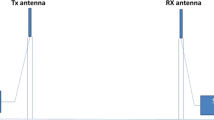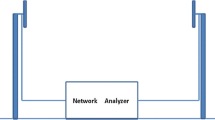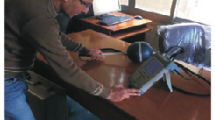Abstract
Propagation loss models for indoor environment are presented. The narrowband directive channel propagation loss in indoor environment at three frequency bands namely (2.4, 3.3 and 5.5) GHz is measured. Sets of directive panel antennas are used in the measurements. RF signal generator and a spectrum analyzer are used in the measurement campaign. It is found that propagation loss is sensitive to the scenario configuration. It is noticed that the propagation loss can be modelled by a single slope propagation model or two slopes propagation model.

















Similar content being viewed by others
References
Tayebi, A., Gomez, J., Saez de Adana, F., & Gutierrez, F. (2009). The application of ray-tracing to mobile localization using the direction of arrival and received signal strength in multipath indoor environments. Progress in Electromagnetics Research, 91, 1–15.
Golparvar Roozbahani, M., Jedari, E., & Shishegar, A. A. (2008). A new link-level simulation procedure of wideband MIMO radio channel for performance evaluation of indoor WLANS. Progress in Electromagnetics Research, 83, 13–24.
Blas Prieto, J., Fernandez Reguero, P., Lorenzo Toledo, R. M., Abril, E. J., Mazuelas Franco, S., Bahillo Martinez, A., & Bullid, D. (2008). A model for transition between outdoor and indoor propagation. Progress In Electromagnetics Research, 85, 147–167.
Yarkoni, N., & Blaunstein, N. (2006). Prediction of propagation characteristics in indoor radio communication environment. Progress in Electromagnetics Research, 59, 151–174.
Howitt, L., & Khan, M. S. (2010). A mode based approach for characterizing RF propagation in conduits. Progress in Electromagnetics Research B, 20, 49–64.
Tummala, D. (2005). Indoor propagation modeling at 2.4 GHz for IEEE 802.11 networks, M.Sc thesis, University of North Texas.
Masson, E., et al. (2009). Radio wave propagation in arched cross section tunnels—simulations and measurements. Journal of Communications, 4(4), 276–283.
Kjeldsen, E., & Hopkins, M. An experimental look at RF propagation in narrow tunnels. Atlanta, Georgia: Scientific Research Corporation (SRC).
Barbiroli, M., Carciofi, C., Degli Esposti, V., Fuschini, F., Grazioso, P., Guiducci, D., Robalo, D., & Velez, F. J. (2010). Characterization of WiMAX propagation in microcellular and picocellular environments. In 2010 Proceedings of the Fourth European Conference on Antennas and Propagation (EuCAP), 1–5, Barcelona, Spain.
Zaballos A., Corral, G., Carné, A., & Pijoan, J. L. (2004). Modeling new indoor and outdoor propagation models for WLAN. www.salle.url.edu/zaballos/opnet/OPNET2004b.pdf.
Gorce, J. M., Runser, K., & de la Roche, G. (2005). FDTD based efficient 2D simulations of Indoor propagation for wireless LAN. www.katia.runser.free.fr/Fichiers/GORCE_IMACS_FINAL.pdf.
Nerguizian, C., Despins, C. L., Affes, S., & Djadel, M. (2005). Radio-channel characterization of an underground mine at 2.4 GHz. IEEE Transactions on Wireless Communications, 4(5), 2441–2453.
Mao, X. H., Lee, Y. H., & Ng, B. C. (2010). Propagation modes and temporal variations along a lift shaft in UHF band. IEEE Transactions on Antennas and propagation, 58(8), 2700–2709.
Poutanen, J., Haneda, K., Salmi, J., et al. (2009). Analysis of radio wave propagation from an indoor hall to a corridor. IEEE Antennas and Propagation Symposium /USNC/URSI, 1–6, 2683–2686.
Ahmed, B. T., Campillo, D. F., & Campos, J. L. (2012). Short range propagation model for a very wideband directive channel at 5.5 GHz band. Progress in Electromagnetics Research, PIER Journal, 130, 319–346.
Author information
Authors and Affiliations
Corresponding author
Rights and permissions
About this article
Cite this article
Ahmed, B.T., Hidalgo, C.A.N. & Campos, J.L.M. Narrowband Short Range Directive Channel Propagation Loss in Indoor Environment at Three Frequency Bands. Wireless Pers Commun 78, 507–520 (2014). https://doi.org/10.1007/s11277-014-1764-5
Published:
Issue Date:
DOI: https://doi.org/10.1007/s11277-014-1764-5




